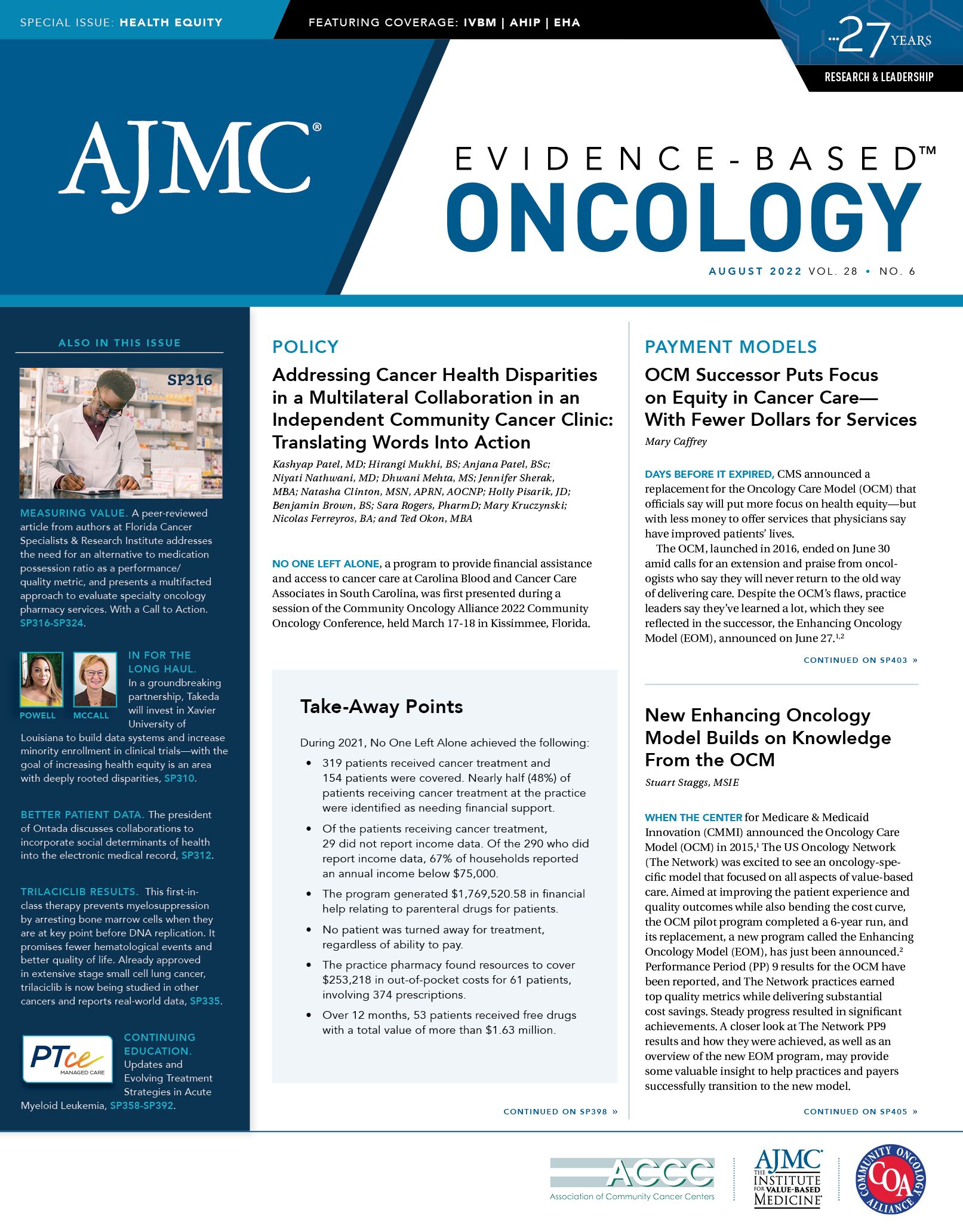- Center on Health Equity & Access
- Clinical
- Health Care Cost
- Health Care Delivery
- Insurance
- Policy
- Technology
- Value-Based Care
A Call to Action: Oncology Practices—and Patients—Need Performance Measures for Managing Oral Therapies
Starting with the first oral targeted therapy, imatinib (Gleevec), introduced in 2001,1 oral targeted agents have evolved into a mainstay of cancer therapeutics. Novel drugs and new indications for existing drugs continue to be approved, offering hope for patients with certain cancer subtypes. These oral oncolytics are very expensive compared with other specialty medications and must be handled and managed with great care and efficiency. Waste-mitigation strategies must be applied to ensure that the drug is not lost due to poor anticipation of some variables in patient care.
Measuring how well an in-house specialty pharmacy in an oncology clinic delivers these services could highlight an important quality indicator to payers and to patients. Unfortunately, as we show in “Defining Appropriate Quality Performance Metrics for Pharmacies Dispensing Oral Oncology Therapies,” pharmacy benefit managers (PBMs) use the medication possession ratio (MPR) as a quality metric despite its lack of relevance to oncology practices. In turn, the MPR is used to assess direct and indirect renumeration (DIR) clawback fees, which cause financial harm both to practices and to patients.
As Florida Cancer Specialists and Research Institute has demonstrated, patients with cancer cannot fully benefit from these novel therapies without high-level clinical and access support. Medically integrated oncology pharmacies like ours, Rx To Go, help patients navigate payer roadblocks to access, mitigate the myriad of financial toxicities these patients face as more and more cost is shifted to them.
Once we have successfully helped patients gain access, our clinical work begins. Rx To Go clinicians use drug-specific, structured oral adherence pharmacy care plans to help patients’ compliance with the prescribed regimens. Further complicating matters, patients are often prescribed to take these oral oncolytics in combination with intravenous drugs.
Coordinating the timely delivery of a prescription-benefit oral drug with a clinic-administered regimen is difficult. Medically integrated oncology pharmacies such RxtoGo are best positioned to help patients and clinic staff navigate these challenges.
Of note, because pharmacists do not have provider status and cannot bill for clinical services, all the services that specialty pharmacies provide are value-added and at great expense to the practice, which relies on prescription dispensing margins. However, ever-increasing DIR fees have been steadily eroding these margins, as progressively more is required of us to help patients with cancer gain access to their prescribed medications and achieve good outcomes.
The DIR fee structure was not designed to evaluate pharmacy dispensing of the oral oncolytics that are critical for patients with cancer. Instead, DIR fees were designed to be applied as a pharmacy performance metric for chronic diseases (eg, hypertension, diabetes, high cholesterol) measured under the CMS Star Rating System for Plan D sponsors.2,3 Nevertheless, PBMs have misapplied these performance metrics to oncology pharmacies, which do not manage any patients with these chronic conditions.
To make matters worse, PBMs use inadequate, simplistic claims-based metrics like MPR to justify DIR clawback fees4,5 charged to specialty pharmacies like Rx To Go. As demonstrated in this issue, MPR alone is a very poor metric for measuring the clinical performance of a pharmacy serving patients being treated with oral oncolytics.
We call on PBMs, plan sponsors, and the Pharmacy Quality Alliance to work with the broader oncology specialty pharmacy community to develop specific performance metrics for these oral therapies. Furthermore, performance metrics should reward high-performing pharmacies, not penalize them as the current DIR clawbacks do. We have suggested several such metrics. More discussion and collaboration among all stakeholders are needed to develop a set of metrics applicable to in-house and other specialty pharmacies that dispense oral oncolytics.
References
1. FDA gives fast approval to Gleevec in treatment of CML. Oncology (Williston Park). 2001;15(6):171050.
2. CMS, HHS. Medicare program; Medicare Advantage and prescription drug benefit programs: negotiated pricing and remaining revisions. Fed Regist. 2009;74(7):1494-1549. Accessed March 8, 2022. https://www.federalregister.gov/documents/2009/01/12/E9-148/medicare-program-medicare-advantage-and-prescription-drug-benefit-programs-negotiated-pricing-and
3. Medicare Part D — direct and indirect remuneration (DIR). News release. CMS; January 19, 2017. Accessed May 3, 2021. https://www.cms.gov/newsroom/fact-sheets/medicare-part-d-direct-and-indirect-remuneration-dir
4. Frier Levitt, LLC. “Performance” based DIR fees: a rigged system with disparate effect on specialty pharmacies, Medicare Part D beneficiaries and the U.S. healthcare system. Community Oncology Alliance. March 1, 2017. Accessed April 30, 2021. https://communityoncology.org/performance-based-dir-fees-a-rigged-system-with-disparate-effect-on-specialty-pharmacies-medicare-part-d-beneficiaries-and-the-us-healthcare-system/
5. Frier Levitt, LLC. Pharmacy benefit manager exposé: how PBMs adversely impact cancer care while profiting at the expense of patients, providers, employers, and taxpayers. Community Oncology Alliance. February 2022. Accessed July 10, 2022. https://communityoncology.org/wp-content/uploads/2022/02/COA_FL_PBM_Expose_2-2022.pdf


